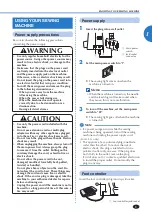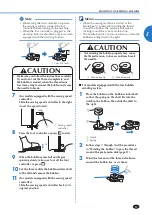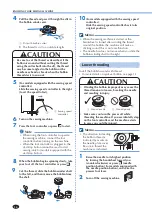
KNOWING YOUR SEWING MACHINE
21
1
Replacing the needle
1
Raise the needle in the following way.
or
1
Turn the handwheel so
that the mark on the
wheel points up.
2
Press the Needle position
button (for the models
equipped with this button).
2
Turn off the sewing machine.
CAUTION
• Before replacing the needle, be sure to turn off
the sewing machine, otherwise injuries may
occur if the foot controller or the start/ stop
button is accidentally pressed and the machine
starts sewing.
3
Lower the presser foot lever.
1
Presser foot
lever
CAUTION
• Before replacing the needle, place fabric or paper
under the presser foot to prevent the needle from
falling into the hole in the needle plate.
4
Remove the needle by turning the needle
clamp screw counterclockwise.
1
Disc-shaped screwdriver
2
Needle clamp screw
Note
• If the needle clamp screw is loosened too
much, the needle clamp (which holds the
needle) may fall off. Therefore, do not
loosen the needle clamp screw too much.
• Do not apply strong force when loosening or
tightening the needle clamp screw, otherwise
certain parts of the sewing machine may be
damaged.
5
With the flat side of the needle toward the
rear of the machine, insert the needle until it
touches the needle stopper.
1
Needle stopper
6
Tighten the needle clamp screw by turning it
clockwise.
• Install the twin needle in the same way.
CAUTION
• Be sure to insert the needle until it touches the
needle stopper and securely tighten the needle
clamp screw with the disc-shaped screwdriver,
otherwise the needle may break or damage
may result.
Sewing with the twin needle
You can sew with this needle and two top threads.
You can use the same color or two different colors of
thread for making decorative stitches.
1
Twin needle
2
Extra spool pin






























